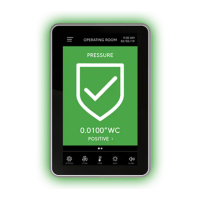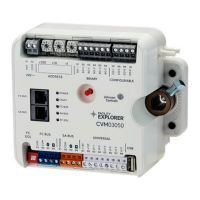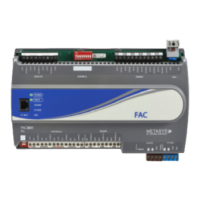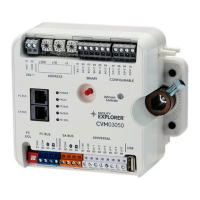FMS-2000C
LIT-12013504
37
Specifying the K-Factor to measure air ow
The default value for the K-Factor is 1.0, but the manufacturer of the sensor can provide a dierent K-Factor to serve as a correction
factor for the actual output of the sensor. If you do not receive a dierent K-Factor from the manufacturer, leave the K-Factor at its
default value. If you have to specify a dierent K-Factor, complete the following steps:
1. On the home screen, tap the Settings icon to enter the Settings menu.
2. To view analog input settings, tap Analog I/O.
3. To nd the analog input you want to adjust, swipe left.
4. On the ANALOG screen, tap K-Factor.
5. Enter the K-Factor that the manufacturer provided with the sensor.
6. To conrm the settings, tap the Checkmark icon.
Calculating air changes per hour
If you want to measure air changes based on modes of occupancy or display air changes on the home screen, calculate air changes per
hour (ACPH). When you enable the calculation of ACPH, you have to enter the room volume and the ACPH setpoints for both occupied
mode and unoccupied mode.
To enter the ACPH setpoints for occupied and unoccupied modes, complete the following steps:
1. On the home screen, tap the Settings icon to enter the Settings menu.
2. To view analog input settings, tap Analog I/O.
3. To set up ANALOG 2 for ow, swipe left once.
4. To enable the calculation of ACPH, switch Calculate ACPH on.
5. Tap the Occupied ACPH Setpoint arrow and enter the setpoint value.
6. Tap the Checkmark icon to conrm your settings.
7. Tap the Unoccupied ACPH Setpoint arrow and enter the setpoint value.
8. Tap the Checkmark icon to conrm your settings.
Note: The occupied and unoccupied specications are only available in AI-2. When you set up AI-3 or AI-4 for ow, you can enter a
room volume value and an ACPH setpoint value only.
Calculating the room volume for ACPH measurement
To calculate the room volume of a rectangular room in cubic feet, multiply the length of the room by the width and the height. For
irregular shaped rooms, determine the value by breaking the room up into multiple smaller rectangular areas and summing the individual
volumes to calculate the total room volume in cubic feet. An approximation can also be specied for the room volume. This volume can
be ne-tuned to increase the accuracy of the displayed air change rate according to the actual volumetric ow oset of the room.
To enter the room volume, complete the following steps:
1. On the home screen, tap the Settings icon to enter the Settings menu.
2. To view analog input settings, tap Analog I/O.
3. To nd the analog input you want to adjust, swipe left.
4. To enable the calculation of ACPH, switch Calculate ACPH on.
5. Scroll down and tap the Room Volume arrow.
6. Enter the room value you have calculated and tap the Checkmark icon to conrm your settings.
Specifying the output signal range for air ow
When you select the 0-5V, 0-10V, 0-20mA range, the analog output swings from zero to maximum specied by the hardware DIP switch
selection. The 1-5V, 2-10V, 4-20mA range includes an oset from zero. To specify the output range, complete the following steps:
1. On the home screen, tap the Settings icon to enter the Settings menu.
2. To view analog input settings, tap Analog I/O.
3. To nd the analog input you want to adjust, swipe left.
4. To specify the output range, expand Range.
5. To select a range, tap one of the following:
• 0-5V, 0-10V, 0-20mA
• 1-5V, 2-10V, 4-20mA
6. Collapse Range to save the new settings.
Adjusting deadband for air ow
This parameter species the deadband applied to the dierential pressure input signal for control purposes. When the input signal is
within the deadband, the corresponding PID control output remains constant.
1. On the home screen, tap the Settings icon to enter the Settings menu.
2. To view analog input settings, tap Analog I/O.
3. To nd the analog input you want to adjust, swipe left.
4. On the ANALOG screen, tap the Deadband arrow.
5. Enter the Deadband value.
6. To conrm the new settings, tap the Checkmark icon.

